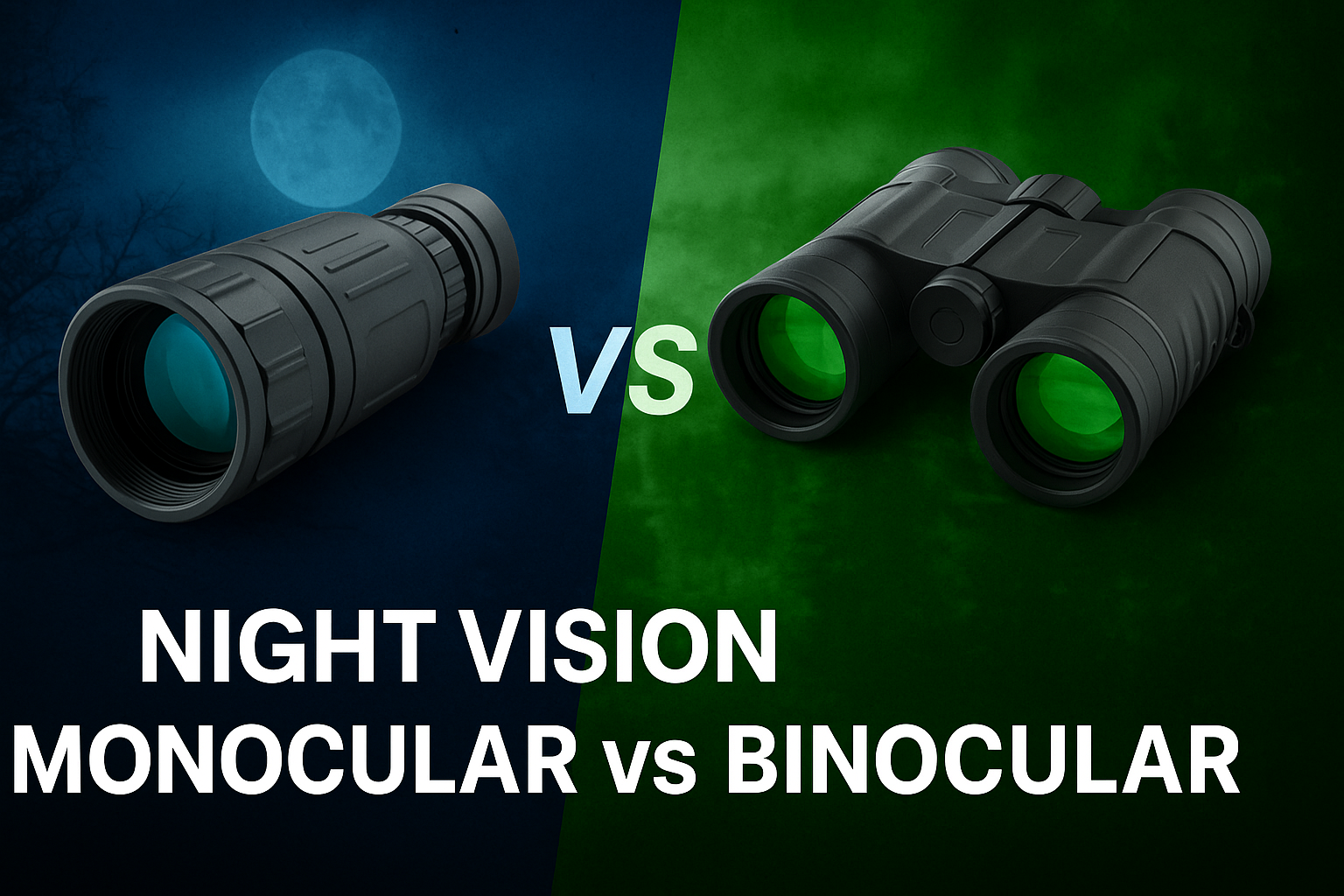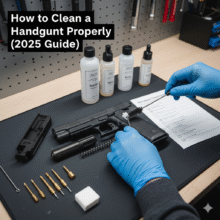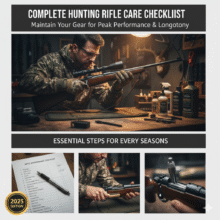Night Vision Monocular vs Binocular: In-Depth Comparison & Buyer’s Guide

Night vision gear is a critical tool for shooters, hunters, wildlife observers, and tactical operators. When light levels drop, having the right night vision device can be the difference between success and failure. Among the most common debates in the field is the choice between a night vision monocular and a night vision binocular (or dual-tube) system.
In this comparison article, we’ll break down the strengths, weaknesses, technical factors, use cases, and decision criteria you should understand before choosing. By the end, you’ll be better equipped to decide which suits your night-time needs — whether for shooting, hunting, surveillance, or general outdoor use.
Table of Contents
- What Are Night Vision Monoculars and Binoculars?
- Key Factors to Compare
- Weight, Fatigue & Ergonomics
- Field of View & Situational Awareness
- Depth Perception & 3D Visualization
- Eye Strain and Long Session Use
- Focusing and Adjustment Complexity
- Versatility, Mounting & Multi-Role Use
- Cost and Value
- Reliability & Optical Alignment
- Transitions & Operational Speed
- 1. Night Hunting & Spotting Game
- 2. Tactical / Law Enforcement Operations
- 3. Surveillance / Observation
- 4. Dual-function with Day Optics or Cameras
- 5. Long Duration Use & Comfort
- Real-World Insights & User Feedback
- Choosing the Right Night Vision Device: A Buyer’s Checklist
- Tips for Maximizing Performance Regardless of Your Choice
- Summary & Final Recommendation
What Are Night Vision Monoculars and Binoculars?
Before comparing, let’s define terms:
- A night vision monocular is a single-tube (single optical path) device that you use with one eye. It may be handheld, helmet mounted (on a goggle mount), or weapon-mounted (using adapters). It’s essentially half a pair of binoculars.
- A night vision binocular (or dual-tube binocular / dual-channel NVG) uses two image intensifier tubes and two optical paths, one for each eye. This allows you to view with both eyes simultaneously.
Some hybrid devices exist (bioculars) in which a single image tube is fed to both eyes, but for this article we’ll mostly compare true monoculars vs true binocular (dual tube) systems.
Key Factors to Compare
When comparing night vision monoculars vs binoculars, several technical and ergonomic factors come into play. Below are the critical parameters you should evaluate.
| Factor | Monocular | Binocular (Dual Tube) | Comments / Trade-offs |
|---|---|---|---|
| Weight & Size | Lighter, more compact | Heavier, bulkier | Dual tubes double up weight and bulk; head fatigue is a concern with long use. |
| Field of View & Awareness | Narrower FOV | Wider FOV, better peripheral awareness | Binoculars give more situational awareness. |
| Depth Perception / 3D Vision | Relies on monocular depth cues | Better stereoscopic depth perception | Dual tubes allow stereopsis, enhancing depth judgment. |
| Eye Strain & Fatigue | Potential strain because only one eye | More natural viewing using both eyes | For long sessions, binoculars may reduce fatigue. |
| Focusing / Adjustment Complexity | Single focus control (one tube) | Dual focus controls (one for each eyepiece) | Binoculars may require more fine adjustment. |
| Versatility & Mounting Options | Highly versatile: handheld, helmet, weapon mount | More limited versatility | Monoculars often support adapters and can double as spotting tools. |
| Cost | Generally lower | Much higher (dual tubes are costly) | For equivalent tube quality, binoculars often cost more than double. |
| Reliability & Alignment | Fewer moving parts, simpler optical alignment | More prone to misalignment (collimation) | Maintaining perfect alignment between two tubes is critical. |
| Operational Speed / Transitioning | Faster transitions (one eye free) | Slight delays switching / aligning dual eyepieces | Some users prefer monocular for faster engagement. |
Let’s dig deeper into each of these points.
Weight, Fatigue & Ergonomics
One of the biggest practical differences is weight. When mounting on a helmet or head gear, every ounce matters. In tests between dual tube setups (e.g. FLIR BNVD-51) and single tube monoculars (e.g. FLIR MNVD-51), the weight difference can exceed 10 ounces. That becomes significant over prolonged use, especially when the device is mounted on the head.
Wearing heavier binoculars can cause neck fatigue, especially in dynamic operations or long hunts, making lighter monoculars an appealing option if weight is a limiting factor.
Field of View & Situational Awareness
Binocular systems offer a wider field of view (FOV), which enables better peripheral awareness. You’ll see motions or threats off to the side more easily, which is especially valuable in hunting, surveillance, or tactical scenarios.
Monoculars, in contrast, have narrower FOVs because you’re only using one optical path. This can limit your situational awareness and may require panning more with your head to catch glances.
Depth Perception & 3D Visualization
One of the strongest arguments for binoculars is depth perception. With two optical channels, your brain can interpret parallax differences and deliver stereoscopic depth cues, which help in estimating distance more accurately.
However, it’s important to know that monocular systems don’t completely lose depth perception. Humans can use monocular cues (like motion parallax, size scaling, focus, and perspective) to judge depth. Still, for tasks where precise depth judgment is critical (e.g. moving through terrain, judging shot distances), binoculars offer a distinct advantage.
Eye Strain and Long Session Use
Using a single eye for extended periods may cause ocular fatigue or visual discomfort, especially if your eyes alternate experience (one eye “sees” through the tube while the other is in darkness). Binoculars balance usage across both eyes, making the viewing experience more natural and less tiring over time.
Focusing and Adjustment Complexity
With a monocular, you adjust one tube — just one focus wheel or dial. Binoculars require synchronization or individual focusing for each eyepiece, which can be fiddlier and slower in practice.In dynamic settings where quick focus is needed, monoculars often offer an edge.
Versatility, Mounting & Multi-Role Use
Monoculars shine in their adaptability: they can be handheld, helmet-mounted, weapon-mounted, or adapted to cameras or spotting scopes. Some monoculars support quick detach adapters, red dot overlays, or coupling with day optics.
Binoculars, due to their bulk and dual-lens geometry, are less flexible in mounting options. You may lose some flexibility in how and where you deploy them.
Cost and Value
A major factor is cost. Dual-tube binocular systems require two high-quality image intensifier tubes and matched optics. This typically drives the price up much more than a monocular device of equivalent tube quality.
If you’re budget-limited, you may get better performance per dollar with a monocular.
Reliability & Optical Alignment
Binoculars demand correct optical alignment (collimation). If misaligned, images can be double or strain the eyes. Maintenance, shocks, or drops can knock alignment out of spec. Monoculars avoid this issue because there’s only one optical path.
Transitions & Operational Speed
Some users argue that monoculars allow faster transitions — e.g. switching between your naked eye and tube eye — because your off-eye remains free (and can remain dark-adapted). Binoculars require moving both eyepieces or aligning to both eyes, which can slow operations slightly.
The ideal choice depends heavily on the intended application. Below are common scenarios and guidance on which device tends to dominate in that context.
1. Night Hunting & Spotting Game
- Sparse, open fields: Binoculars may help you scan large areas and detect movement across periphery more easily.
- Dense terrain or brush: A monocular may be more practical, lighter, easier to maneuver.
- Weapon integration: If you plan to mount night vision on your rifle or use a red dot overlay, monoculars often have more mounting flexibility.
2. Tactical / Law Enforcement Operations
- When precision, depth judgment, and threat awareness matter, binoculars offer advantages.
- But in scenarios needing mobility, quick transitions, or use of multiple devices (laser, scope, IR illuminator), monoculars may offer tactical flexibility.
- Also, for covert ops or fast transitions between NVG and unaided eyes, monoculars allow one eye to remain dark adapted.
3. Surveillance / Observation
- For stationary observation, binocular systems provide a more immersive viewing experience.
- But if the operator wants to shift to handheld or mobile roles, the lighter, more compact monocular is often preferred.
4. Dual-function with Day Optics or Cameras
- Because monoculars can often be adapted, mounted, or coupled with daytime optics, they are ideal for users who want multi-purpose use.
- Binoculars are comparatively more specialized and less adaptable for cross-function use.
5. Long Duration Use & Comfort
- For long surveillance, stakeouts, or multi-hour field sessions, binoculars may reduce fatigue due to balanced eye use.
- However, for head-mounted use over long durations, the extra weight of binoculars might induce neck strain, tilting the balance in favor of monoculars.
Real-World Insights & User Feedback
To enrich theoretical comparison, here are a few real-world observations from users and experts:
- A user on a night vision forum wrote: “I’d rather have a higher quality monocular … the only real advantage to duals is better depth perception and looking cooler, while monos are cheaper, lighter (usually), and give you the ability to see ambient conditions with your non-tubed eye.”
- In dual vs single tube tests, some observers found depth perception was better with dual tubes, but monoculars could closely match performance after training.
- On Sniper’s Hide, a spec-ops veteran recommended the monocular (PVS-14) approach because it allows one eye to remain dark-adapted and better transitions to non-NVG vision.
- Manufacturers often discuss the trade-off: monoculars are more versatile and budget-friendly, while binoculars offer immersive depth and comfort at higher cost.
These accounts align well with the technical pros/cons discussed above — a practical user base often values flexibility and weight savings, while high-end users accept the cost/weight penalty for the benefits of binoculars.
Choosing the Right Night Vision Device: A Buyer’s Checklist
Here’s a decision flow you can use when selecting between a monocular and binocular NVG:
- Define your primary use
- If you anticipate a lot of movement, weapon use, or mounting, lean monocular.
- If your main goal is observation, depth judgment, or immersive viewing, binocular may be better.
- Set a weight or ergonomics threshold
- If head-mounted weight must stay below a certain level, a monocular may be your only viable combination.
- Decide on mounting flexibility / multi-function use
- If you want dual use (spotting, camera, rifle mount), monoculars often support them more readily.
- Budget constraints
- If cost is a concern, a high-quality monocular may outperform a cheap binocular.
- Trial or testing if possible
- If you can rent or test both systems, the personal comfort, feel, and eye strain differences become obvious.
- Plan for future upgrades / parts
- Consider availability of tubes, optics, and accessories; dual-tube systems may need matched replacements, which are more expensive.
- Training and adaptation
- Be prepared: monocular use may require more adaptation. Using both eyes open (one with NV, one not) is a learning curve.
Tips for Maximizing Performance Regardless of Your Choice
Whatever you choose, here are some best practices:
- Maintain alignment and calibration: Even binoculars need periodic checks to ensure collimation.
- Use low-profile mounts to optimize the center of gravity and reduce neck strain.
- Train your eye adaptation: Practice switching between naked vision and NVG vision to smooth transitions.
- Use IR illuminators where allowed (if permitted by local regulations) to boost performance in low ambient light.
- Keep tubes clean and dry: moisture, dirt, or shock can degrade performance or misalign optics.
- Allow for spare parts: tubes, batteries, lens covers, and accessories are key to keeping gear mission-ready.
Summary & Final Recommendation
Both night vision monoculars and binoculars have unique advantages. Monoculars are lighter, more versatile, and budget-friendly perfect for hunters or shooters who need mobility. Binoculars offer better depth perception and comfort for long use but are heavier and more expensive. Choose a monocular for flexibility and value, or a binocular for immersive, high-performance viewing in the dark.







